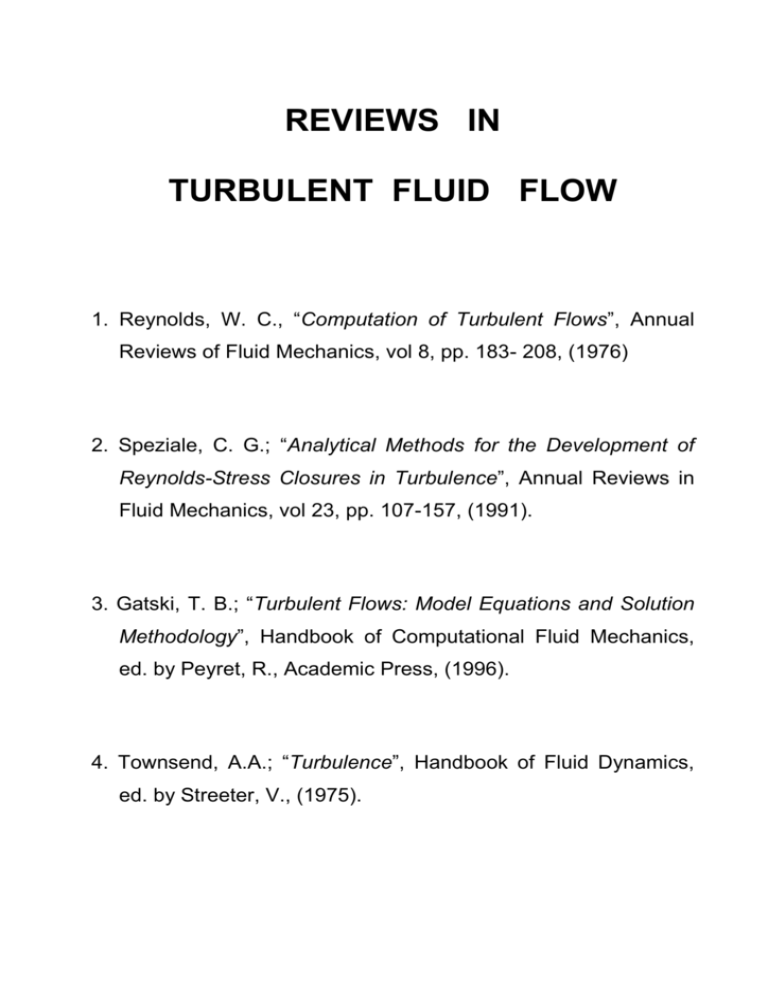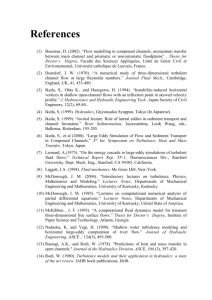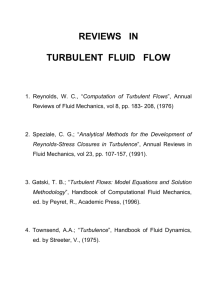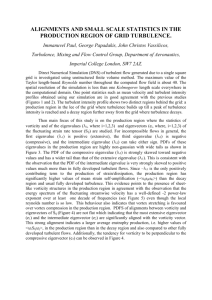reviews in
advertisement

REVIEWS IN TURBULENT FLUID FLOW 1. Reynolds, W. C., “Computation of Turbulent Flows”, Annual Reviews of Fluid Mechanics, vol 8, pp. 183- 208, (1976) 2. Speziale, C. G.; “Analytical Methods for the Development of Reynolds-Stress Closures in Turbulence”, Annual Reviews in Fluid Mechanics, vol 23, pp. 107-157, (1991). 3. Gatski, T. B.; “Turbulent Flows: Model Equations and Solution Methodology”, Handbook of Computational Fluid Mechanics, ed. by Peyret, R., Academic Press, (1996). 4. Townsend, A.A.; “Turbulence”, Handbook of Fluid Dynamics, ed. by Streeter, V., (1975). MODELO K-E E SUAS VARIANTES 1. Launder, B. E. and Spalding, D.B.; “The Numerical Computation of Turbulent Flows”, Comp. Methods in Applied Mech. And Engng., vol. 3, pp. 269-289, (1974). 2. Mohammadi, B. and Pironneau, O.; “Applied Mathematics and Turbulence Modelling”, Int. J. for Numerical Meth. In Fluids, vol. 20, pp. 819-829, (1995). 3. Zijlema, M., Segal, A. and Wesseling, P.; “Invariant Discretization of the K-E Model in General Co-ordinates for Prediction of Turbulent Flow in Complicated Geometries”, Computers and Fluids, vol. 24, pp. 209-225, (1995). 4. Shih, T., Liou, W.W., Shabbir, A., Yang, Z. and Zhu, J.; “A New K-E Eddy Viscosity Model for High Reynolds Number Turbulent Flows”, Computers Fluids, vol. 24, n. 3, pp. 227-238, (1995). 5. Chen, Y.S. and Kim, S.W.; “Computation of Turbulent Flow Using an Extended K-E Turbulence Closure Model”, NASA REPORT, CR 179204, October (1987). 6. Yakhot, V. and Orszag, A.S.; “Renormalization Group Analysis of Turbulence – Basic Theory”, J. of Scientific Computing, vol. 1, n.1, pp. 3-51, (1986). 7. Yakhot, V. and Orszag, A.S., Thangam, S., Gatski, T.B. and Speziale, C.G.; “Development of Turbulence Models for Shear Flows by a Double Expansion Technique”, Phys. Of Fluids A, vol.4, n.7, pp. 1510-1520, (1992). 8. MEDIDAS EXPERIMENTAIS 1. Hanjalic, K. and Launder, B.E., “Fully Developed Asymetric Flow in a Plane Channel”, J. Fluid Mech., vol. (51), part 2, pp. 301-335, (1972) 2. Launder B.E. and Ying W.M.; “Secondary Flows in Ducts of Square Cross-Section”, J. Fluid Mech., vol (54), part 2, pp. 289-295, (1972) 3. Durst, F., Melling, A. and Whitelaw, J.H.; “Low Reynolds Number Flow Over a Plane Symmetric Sudden Expansion”, J. Fluid Mech. , vol. 64, part 1, pp. 111-128, (1974). 4. Hussain, A.K.M.F. and Reynolds, W.C.; “Measurements in Fully Developed Turbulent Channel Flow”, Trans. ASME – J. Fluids Engng. pp. 568-580, December (1975). 5. Durst, F., scherholz, W.F. and Wunderlich, A.M.; “Experimental and Numerical Investigations of Plane Duct Flows with Sudden Contraction”, J. Fluids Engn – Trans. ASME, vol 109, pp. 376-383, December (1987). 6. Liou, T.M, Kao, C.F., “Symmetric and Asymmetric Turbulent Flows in a Rectangular Duct with a Pair of Ribs”, J. Fluids Engn. – Trans. ASME, vol. 110, pp. 373-379, December, (1988). 7. Lim, K.S., Park, S.O. and Shim, H.S., “A Low Aspect Ratio BackwardFacing Step Flow”, Exp. Thermal and Fluid Sci.vol. 3, pp. 508-514, (1990). 8. Clark, J.A.; “A Study of Incompressible Turbulent Boundary Layers in Channel Flow”, J. of Basic Engn. – Trans. ASME, pp. 455-468, December, (1968). 9. Meyer, L.; “Calibration of a Three-Wire Probe for Measurements in Nonisothermal Flow”, Exp. Thermal and Fluid Sci, vol. 5, pp. 260-267, (1992). 10. George, W.K., and Taulbee, D.B.; “Designing Experiments to Test Closure Hypothses”, Exp. Thermal and Fluid Sci, vol. 5, pp. 249-259, (1992). 11. Kim, W.J. and Patel, V.C.; “Origin and Decay of Longitudinal Vortices in Developing Flow in a Curved Rectangular Duct”, J. Fluids Engng. Trans. ASME, vol 116, pp. 45-52, March, (1994). COMPARAÇÃO ENTRE MODELOS 1. Chen, Q.; “Comparison of Different K-E Models for Indoor Air Flow Computations”, Numerical Heat Transfer, Part B, vol 28, pp. 353-369, (1995). 2. Sarkar, S. and Bose T.K.; “Comparison of Different Turbulence Models for Prediction of Slot-Film Cooling: Flow and Temperature Field”, Numerical Heat Transfer, Part B, vol. 28, pp. 217-238, (1995). 3. Dutta, S. and Acharya, S.; “Heat Transfer and Flow Past a Backstep with the Nonlinear K-E Turbulence Model and the Modified K-E Turbulence Model”, Numerical Heat Transfer, Part A, vol. 23, pp. 281301, (1993). 4. Martinuzzi, R. and Pollard, A.; “Comparative Study of Turbulence Models in Predicting Turbulent Pipe Flow Part I: Algebraic Stress and K-E Models”, AIAA J., vol, 27, n.1, January, (1989). 5. Gerodimos, G. and So, R.M.C.; “Near-Wall Modelling of Plane Turbulent Wall Jets”, J. Fluids Engng. Trans ASME, vol. 119, June, (1997). 6. Sotiropoulos, F. and Ventikos, Y.; “Flow Through a Curved Duct Using Nonlinear Two-Equation Turbulence Models”, AIAA J., vol. (36), n.7, July, (1998). STRESS MODELS 1. Hanjalic, K. and Launder, B.E.; “A Reynolds Stress Model of Turbulence and its Application to Thin Shear Flows”, J. Fluid Mech. Vol. 52, part 4, pp. 609-638, (1972). 2. Demuren, A. O. and Rodi, W.; “Calculation of Turbulence-Driven Secondary Motion in Non-Circular Ducts”, J. Fluid Mechanics, vol. 140, pp. 189-222, (1984). 3. Warfield, M.J. and Lakshminarayana, B.; “Computation of Rotating Turbulent Flow with an Algebraic Reynolds Stress Model”, AIAA J., vol. 25, n. 7, July, (1987). 4. Gatski, T.B. and Speziale, C.G.; “On Explicit Algebraic Stress Models for Complex Turbulent Flows”, J. Fluid Mech., vol. (254), pp. 59-78, (1993). 5. Shih, T.H., Zhu, J. and Lumley, J.L.; “A New Reynolds Stress Algebraic Equation Model”, Comput. Methods Appl. Mech. Engng., vol. 125, pp. 287-302, (1995). LAW OF THE WALL & FUNDAMENTALS 1. Panton, R.L.; “Scaling Turbulent Wall Layers””, (1990) 2. Spalding, D.B.; “A Single Formula for the Law of the Wall”, (1961) 3. Van Driest, E.R., “On Turbulent Flow Near a Wall”, (1956) 4. Kutateladze, S.S.; “The Mixing Length Hypothesis in Turbulence Theory”, (1984) 5. Hinze, J.O.; “Secondary Currents in Wall Turbulence”, (1961) 6. Bradshaw, P. and Huang, G.P., “The Law of the Wall in Turbulent Flow” 7. Cruz, D.O.A., et al, “Uma Formulação de Lei de Parede para Escoamentos Turbulentos com Separação e trocoa de Calor” 8. Yoshizawa, A. and Nisizima, S.; “A nonequilibrium representation of the turbulent viscosity based on a two-scale turbulence theory” 9. Bradshaw, P. and Perot, J.B.; “A note on turbulent energy dissipation in the viscous wall region” K-E MODELS FOR LOW REYNOLDS NUMBER FLOWS 1. Patel, V.C., Rodi, W. and Scheuere, G.; “Turbulence Models for NearWall and Low Reynolds Number Flows: A Review”, (1984) 2. Jones, W.P. and Launder, B.E.; “The Calculation of Low-Reynolds Number Phenomena with a Two-Equation Model of Turbulence”, (1972). 3. Lam, C.K.G. and Bremhorst, K.; “A Modified Form of the K-E Model for Predicting Wall Turbulence”, (1981). 4. Nagano, Y. and Tagawa, M.; “An Improved K-E Model for Boundary Layer Flows”, (1990) 5. Abe, K., Kondoh, T. and Nagano, Y.; “A New Turbulence Model for Predicting Fluid Flow and Heat Transfer in Separating and Reattaching Flows – I. Flow Field Calculations”, (1993). 6. Rousseau, A.N., Albright, L.D. and Torrance, K.E.; “A Short Comparison of Damping Functions of Standard Low-Reynolds-Number K-E Models”, (1997). STREAMLINE CURVATURE EFFECTS ON WALL BOUNDE D TURBULENT FLOWS 1. Bradshaw, P.; “Turbulent Secondary Flows”, (1987). 2. Patel, B.C. and Sotiropoulus, F.; “Longitudinal Curvature Effects in Turbulent Boundary Layers”, (1997) 3. Luo, J. and Lakshiminarayana, B.; “Analysis of Stream Line Curvature Effects on Wall-Bounded Turbulent Flows”, (1997). 4. Launder, B.E., Priddin, C.H. and Sharma, B.I.; “The Calculation of Turbulent Boundary Layers on Spinning and Curved Surfaces”, (1977). 5. Lakshiminarayana, B.; “Turbulence Modeling for Complex Shear Flows”, (1986).






